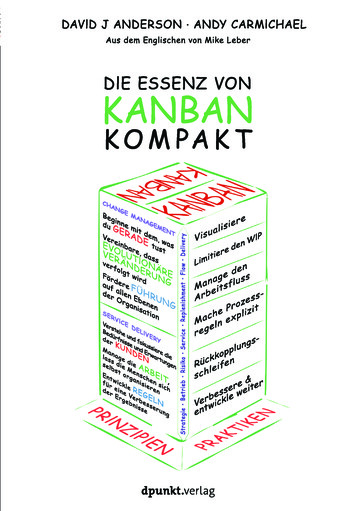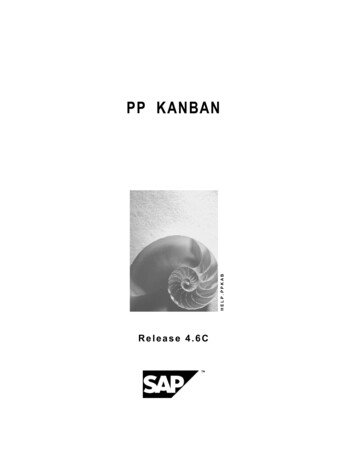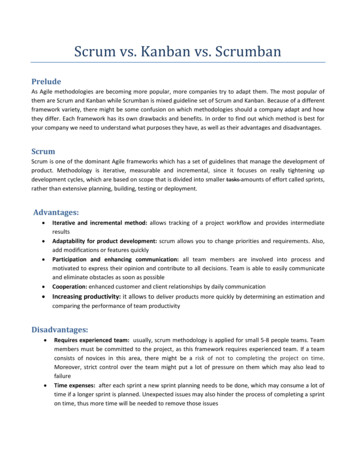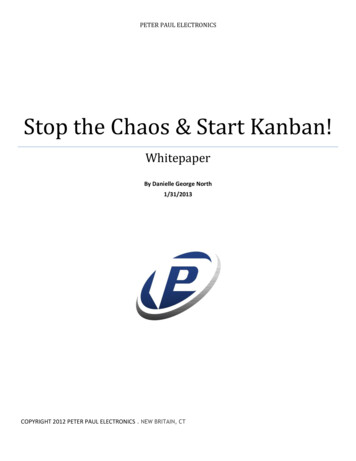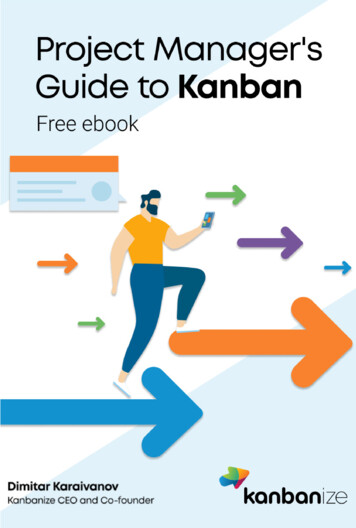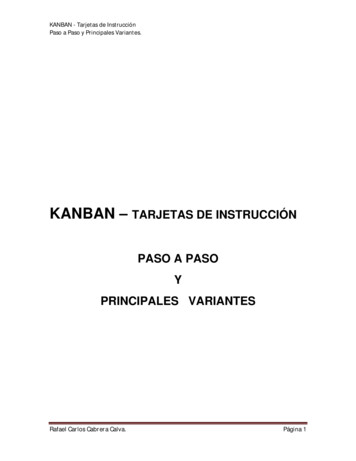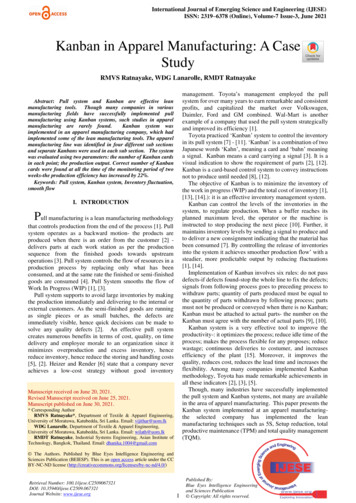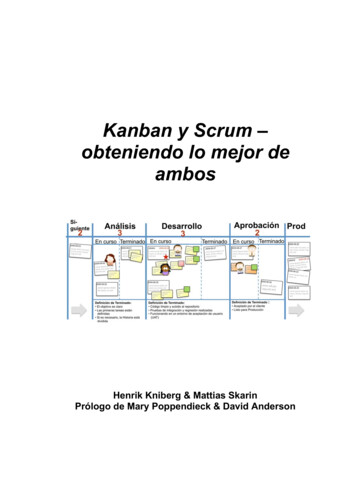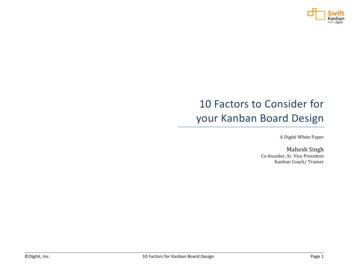
Transcription
WHAT IS KANBAN?
What is Kanban? 2FOCUS ON FREQUENT PRODUCT DELIVERY,TEAMWORK/COLLABORATION, CONTINUOUSIMPROVEMENTWhen you first hear it, Kanban sounds like it could be the name of a movie dog, or a new dance move, or a video game.It’s actually a Japanese word meaning “sign” or “billboard” and it is one of the most widely used Agile-based frameworks.Its focus on frequent product delivery, teamwork/collaboration, continuous improvement, and other practices, link it tothe concepts described in the Agile Manifesto. Once used almost exclusively in Lean manufacturing and later in softwaredevelopment, it is embraced as both an alternative and a complement to Scrum.Kanban is more than a flow-based project delivery model. Although not as widely known, it is also a method of changemanagement. The Kanban board is perhaps the most recognizable component, as it is the tool used to visualize and trackthe flow of value.Figure 1: The Kanban Board (numbers above each state indicate Work In Progress limits)
What is Kanban? 3From Lean Manufacturing to Widespread UseLike Scrum, Kanban originated in Lean manufacturing. In the 1940’s, Taiichi Ohno, a Japanese industrial engineer workingat Toyota automotive, developed Kanban to better control and manage inventory at all stages of automobile production.The system relied on an instruction card (ultimately evolving into the Kanban board) that moved along the production line.Kanban’s use for software development can be traced back to a book written by David J. Anderson (titled Kanban) thatdescribed the evolution of the approach starting with a Microsoft project in 2004.The adoption of Kanban started slowly and then exploded. In 2006, the first annual State of Agile survey of softwaredevelopers was published. Since its inception, the survey questionnaire has included the question: “Which Agilemethodology do you follow most closely?” No mention of Kanban appeared in survey results until 2009. As the followinggraph in Figure 2 indicates, the use of Kanban grew at a remarkable rate.Figure 2: The Adoption of Kanban over time (Source: Collabnet/VersionOne Annual State of Agile Reports)Kanban is now one of the most widely embraced Agile methodologies. Understanding why it has been so successfulrequires an understanding of how it works.So What is Kanban?According to David Anderson, it is “a method of defining, managing, and improving services that deliver knowledgework.” The origin of the work starts with a request from the customer – either by a direct request or by othersrecognizing a need. The work is considered done when the requestor (or their proxy) acknowledges the request hasbeen fulfilled.
What is Kanban? 4The Kanban method provides a means of designing, managing, and improving flow systems for knowledgework. Intangible work items proceed through various steps that ultimately provide a result of value to thecustomer. Kanban is a “pull system” which means that the team pulls work into the workflow when theyhave the capacity to devote to it as opposed to a “push system” in which the work is pushed on the teamregardless of their existing workload. The types of knowledge work, aside from software development,that now routinely apply Kanban principles include marketing campaigns and other types of productdevelopment or creative work projects, engineering and other professional services, large-scale hiringendeavors, and other endeavors requiring highly-organized, visible task tracking and management.In the book Essentials of Kanban, Anderson and Andy Carmichael describe the core practices of the KanbanMethod: Visualize work Limit Work in Progress Manage Flow Make Policies Explicit Implement Feedback Loops Improve and EvolveKanban – A Glimpse Under the HoodOne of the aspects of Kanban that many users find attractive is that it is an evolutionary rather than adisruptive method – it starts with mapping an organization’s current processes and promotes gradualimprovements to improve work flow, reduce cycle time, and increase value to the customer – while offeringgreater insight and consistency.Knowing and understanding a handful of key Kanban concepts foster an appreciation of why Kanban hasbecome so widely embraced.Kanban – A Glimpse Under the HoodA Kanban System is a service (provided to an internal or external customer) with clear entry and exit criteria.It is a delivery flow system that uses visual signals (the Kanban board) to limit the amount of Work in Progress(WIP).The Kanban BoardThe Kanban board, probably because it is the most tangible and visible of the Kanban-related concepts, isoften incorrectly thought of by some as the “soul” of Kanban. It’s not. The Kanban System, discussed in thefollowing section, is bigger than just using the board. The purpose of the board is to visualize the workflow.The tools used to visualize the workflow are Kanban Cards. Each card is a visual representation of a specificwork item, task, or idea and contains information related to that item including the person(s) responsible,deadlines, a summary of the assignment, etc.
What is Kanban? 5In Figure 1 above, the states are Idea, Ready, In Progress, Confirming, and Done. Specific states depicted onthe board are selected by identifying those work states appropriate to the type of work and the organization.For one type of work, those states might be Analyze, Review, Build, Integrate/Test, and Accept. A differentwork type would have states best matched to its flow.Team members can augment the information on the cards. The Kanban cards are placed in the column ofthe Kanban board that represents its status. They are then moved across the board from left to right as theirstatus changes, in accordance with the defined entrance and exit policies for each state, until the item iscompleted. The cards offer a couple of important benefits: Visibility of the work and processes is enhanced giving team members and stakeholders a clearer pictureof the status of their work at any time. They offer valuable information about the work item and the flow that can improve work processes.Most of the states will have Work In Process (WIP) limits that cap the amount of work within the state so thatteams can better manage flows to create value. WIP Limits increase the flow of value since the teams movefrom starting work to finishing it. A work item can only be pulled into a state when the number of work itemsalready in that state is lower than the WIP limit. WIP limits are created and can be modified by the team.How Kanban WorksKanban prescribes three service delivery principles: Understand and focus on your customers’ needs and expectations Manage the work and let people self-organize on performing the work Continue to establish and revise policies to enhance customer and business resultsThese principles shift an organization’s focus from keeping workers busy to maximizing the amount of valuethe organization delivers. The work flow becomes visible and more manageable by putting it on the Kanbanboard. Work items are tracked from when they enter the system until they leave which offers insight into theamount of work in process and lead times. Teams that spend time considering the flow process are morelikely to spot opportunities for improvement.Two other related Kanban concepts important to understanding how Kanban works are Cost of Delay (CoD)and Classes of Service (CoS). Cost of Delay is the total value lost during the time waiting for the work to bedelivered. CoD is the primary measure teams use when classifying and prioritizing their work items, and, asdescribed below, CoD informs the Class of Service (CoS) for each request.Kanban guru David Anderson describes Class of Service as guiding policies describing how work itemsare treated that are established in accordance with customer expectations. He suggests starting with fourclasses of service: Expedite, Fixed Delivery Date, Standard, and Intangible.
What is Kanban? 6 ExpediteThese are top priority items requiring immediate attention. The CoD for these items is unacceptablyhigh. These preempt other work and can be pulled into the work flow when doing so exceeds WiP limits.If too many items (usually meaning more than one) are classified as Expedite then the CoS is prone toabuse. Fixed Delivery DateWork items in this class have a significant CoD if not delivered on the fixed date. Items in this classcan be prioritized so that they are finished before or on the delivery date. This CoS is often used whendependencies between teams need to be managed. StandardThese are non-urgent items and have no fixed timeline. They make up a significant portion of the team’sworkload and are usually treated as first-in-first-out. IntangibleThese are items lacking a meaningful CoD.Using the classes of service to prioritize work items optimizes the flow of value in Kanban systems with thegoals of minimizing lead times as well as value and offering as much predictability as possible.While the Kanban method does not mandate timeboxes for managing work, it does recommendestablishing a cadence for specific types of feedback loops, including: strategy alignment, operationalcoordination, risk management, service improvement, work replenishment, flow, and customer deliveries.Realizing Value from KanbanKanban, like the processes it guides, has a lot of moving parts. Organizations that adopt Kanban to avoidthe overhead sometimes associated with Scrum (meeting time, staffing of specified roles, etc.) can takeshortcuts that demean its purpose. Keeping an eye on whether or not Kanban drives the timely creation ofvalue allows users to tweak or overhaul the system to enhance its effectiveness. Here are some importantitems to watch. Have you properly mapped the value stream, identified the waste, and proposed actions to reduce waittimes? Do your people understand the method and how to use it for improving delivery? Are the policies clear, respected, and revised over time? Some people think Kanban requires less discipline than other frameworkrs. Because it is not as tightlyprescriptive as Scrum, etc., it actually requires much more.Kanban and AgileKanban enthusiasts might argue that since the Kanban Method enables self-organizing teams to proposeand carry out process improvements as appropriate while focusing on satisfying the customer, Kanban is themost agile method. Given this perception, the rapid adoption of Kanban shouldn’t be a surprise.
Kanban enthusiasts might argue that since the Kanban Method enables self-organizing teams to propose and carry out process improvements as appropriate while focusing on satisfying the customer, Kanban is the most agile method. Given this perception, the rapid ado
